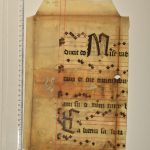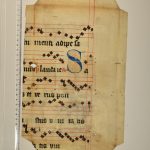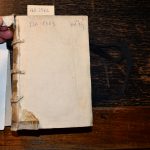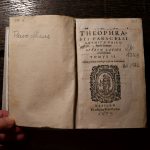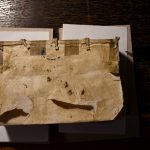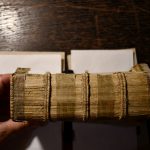After the restoration and the removal of the parchment fragment serving originally as the cover, the carrier book was not rebound, but the imprint of the removed fragment is faintly visible on the bare front page. The spine is strengthened by four narrow strips of parchment, however, these do not originate from the mother codex of the main fragment.
The fragment preserved a part of the first Verpers of the office Sacerdos in aeternum for the feast of Corpus Christi. Albeit the opening antiphon (Sacerdos in aeternum) is missing, we can infer it’s presence from the mode-1 psalm differentia and from the order of the subsequent antiphons.
The responsory in the Vespers (Sacerdos summus et verus) is extremely rare — Homo quidam fecit is used to be here. This chant is a part of the Historia Animarum cibus, a presumable work of Juliana du Mont-Cornillon of Liège. In a similar function, our responsory can be documented only from the 12th–14th century liturgical compedium of Onze-Lieve-Vrouw kerk of Tongeren (Den Haag, Koninklijke Bibliotheek – Nationale Bibliotheek van Nederland, 70 E 4, f. 87r, see in the CANTUS database: http://cantus.uwaterloo.ca/source/123657). To our knowledge this office hasn’t been identified in any sources from Bohemia. More information about the Corpus Christi offices in European and Hungarian medieval sources see Anna Sanda, “Sapientia aedificavit“ : Phasen der Entstehung des Offiziums und der Kodifikation eines spätmittelalterlichen Festes”, in Zenetudományi Dolgozatok 2015-2016: In memoriam Kiss Gábor, ed. Gilányi Gabriella – Kiss Gábor (Budapest: Institute for Musicology of the Hungarian Academy of Sciences, 2018), 61–88.
Gabriella Gilányi, Zsuzsa Czagány


